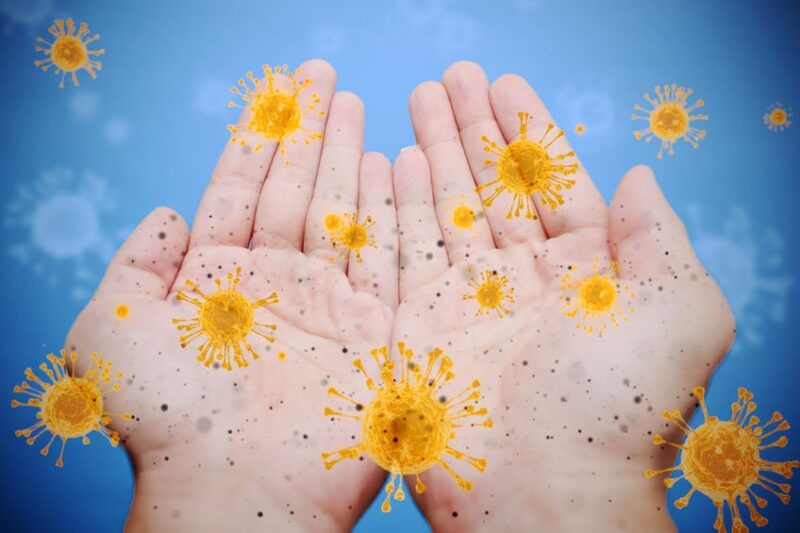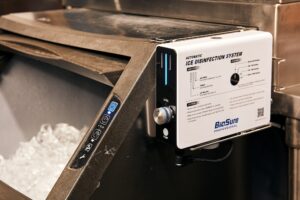Since the beginning of the COVID-19 outbreak, 75% alcohol or isopropyl alcohol spray has been one of our best friends for sanitizing our hands after handwashing. It effectively kills viruses by breaking the cell wall and eliminating the threat. Similarly, ozonated water can serve many of the same functions. It is used in hospitals and dentist offices, as well as in the food industry — for disinfecting water and surfaces. Thanks to ozone’s efficient oxidizing rate, it works in seconds and leaves behind no chemical residues.
This makes ozone spray a great choice for disinfection in spaces that are prone to be hotbeds for bacteria and viruses. Some of these are hospitals and nursing homes, bottling plants, and central kitchens. Thanks to the molecular reactivity of ozone and its ability to quickly bond with other molecules, ozone spray is a powerful and safe disinfectant. Ozone oxidizing particles will neutralize biological matter, such as bacteria or viruses. This makes it an effective disinfectant, and incredibly potent when it is infused in water.

Ozone spray does not affect the pH levels of target surfaces and doesn’t create any chemical byproducts after use. This means that it leaves behind no odors or abnormal tastes after treatment. In contrast, 75% alcohol sprays will leave behind some residue, and in the case of medical equipment used in the healthcare industry, alcohol sprays leave a pungent odor or taste, damages plastic and leather, and also causes dry skin.
Ozone as a Hand Sanitizer
When it comes to ozone spray and alcohol sprays for use as hand sanitizers, one study involving 30 participants found that ozone spray was more effective than alcohol spray for neutralizing the E. Coli bacteria. Furthermore, 20 percent of the participants reported adverse skin effects from the alcohol-based sanitizer, while no participants reported negative effects from the ozone spray.

In considering whether to use a 70-80% alcohol spray or an ozone spray, ozone has the advantage of being able to act on free radicals or bacterial agents while it is in the air, whereas alcohol-based disinfectant sprays do not. They must be sprayed onto a surface and wiped across it to work effectively on harmful bacteria and other microorganisms. On the other hand, ozone, as natural gas, will begin neutralizing these substances whether they are airborne or settled onto a surface.
With shortages of crucial medical resources and protective gear during the COVID-19 pandemic, many people have been looking for alternative disinfectant methods. Targeted studies have recently confirmed that ozone spray is effective in neutralizing the COVID-19 virus on surface areas. This is due to the way ozone immediately seeks to interact with bacteria and viruses on a molecular level once it comes into contact with them.

Researchers in Japan have recently discovered that ozonated water can kill COVID-19. The revolutionary Space Sanitizer System from BES can be placed in a home or in a public area to sanitize a space. It releases ozone into the air as a mist and it works by using patented electrolysis technology to convert water into high purity ozone gas that is safely mixed and misted into the environment. It’s safe to use when people are in the room. This can eliminate bacteria and viruses in the air and on nearby surfaces without leaving harmful chemical residues.
Practical Benefits of Ozone Spray
Ozone spray bottles such and particularly the Mobile Ozone Spray (MOS) from Biolux is the most advanced ozone spray on the market. This is due to its ability to produce a higher concentration of ozone and its remarkable ease of use. Just fill it with tap water and push the charge button, and it works in minutes.

Since disinfecting with ozone only requires the ozonation device and water, this means there is no need to purchase or store large amounts of harmful chemicals or special containers in a particular environment. On top of this, alcohol spray stored in large amounts poses a flammability risk. This is an important factor to consider relative to any potential fire hazards in a target environment.

Additionally, using an ozone spray bottle like the MOB greatly reduces the time of the sanitization process. Since you are disinfecting with water and won’t be leaving any harmful residue behind, you are effectively combining the wash and rinse phases of the cleaning process. Once sprayed onto the target surface, after wiping down the surface the ozone will return back to oxygen, leaving the area free of harmful microorganisms and chemical residue.
Lastly, ozone spray can save costs over the long term. When using ozone spray as a disinfectant, there is no need to use excess water to cut chemicals, activate disinfectant properties, or go through an extra rinse phase. Ultimately, using ozone will cut down on water consumption for many businesses. Ozone also can kill bacteria at much lower temperatures than disinfectant methods which require water heated to higher temperatures. This will also help businesses to reduce regular energy consumption.
As ozone technology becomes more affordable, using ozone spray as a disinfectant is becoming a desirable option for many. Those looking for a convenient and sustainable way of disinfecting surfaces in their home or business should consider ozone spray as a new, more sustainable standard.
Copyright besgroups.com All Rights Reserved
Related Articles
How Ozonated Water Works
Is Ozone Harmful to Humans?
Chlorine Solution vs Ozonated Water: The Debate in Professional Sanitation



